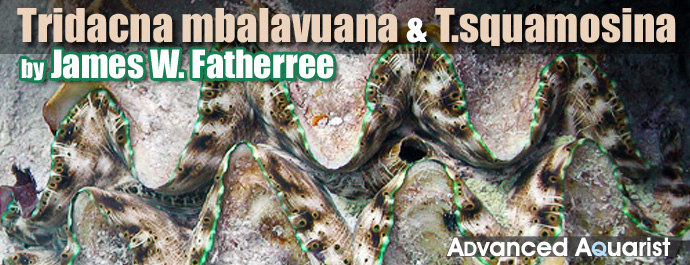
At the time I wrote Giant Clams in the Sea and the Aquarium (2006), Tridacna crocea, T. maxima, T. squamosa, T. derasa, T. gigas, Hippopus hippopus, and H. porcellanus had been imported for the US reef aquarium hobby. It’s time for some updating though, as another species, T. mbalavuana (tevoroa) has now been imported here, and three new species have been described. Of these three, T. squamosina (costata) was the first new one, so I’ll give you some information on T. mbalavuana and this species, and cover the other new species in a follow-up article.
Tridacna mbalavuana:
While doing surveys of giant clam populations in Fiji in 1985, a few unusual giant clams were found, which got the attention of researchers. The clams were similar to T. derasa, but distinguishable, and after more were collected and studied it was suggested that they might represent a new species. Of course, the locals had already noticed this clam and had named it the devil clam, which is tevoro in Fijian. So, at first it was just called the tevoro clam, and subsequently named Tridacna tevoroa.1,2,3 However, it was later found that this clam had been previously described and named T. mbalavuana in 1934, albeit based only on shells/fossil specimens.4 So, T. tevoroa became a junior synonym of T. mbalavuana.
Further searching eventually led to the discovery of this clam in various areas in the eastern Lau Islands of Fiji and the northern Vava’u and Ha’apai islands of Tonga.3 However, there have apparently been some unverified reports of it living on the outer fringes of the Great Barrier Reef, too.5 So, its known range may be greatly extended in the future if these reports can be verified. If not, then this species has a very small range relative to most other species, and it’s relatively rare within its range, as well. In fact, only one was found for every fifty T. derasa around Vatoa, Fiji.1
It’s also important to note that this species typically lives in deeper waters than the rest, and holds the depth of occurrence record. Most are found at depths of 20 to 30m, but the deepest-living one reported in the literature was found at 33m (almost 110 feet).3,6 Conversely, all other species of giant clam are found in significantly shallower water, with T. derasa being in second place at 25m.7
As far as looks go, the shell is grayish-white, and often bears unusual red patches/bands near the bottom. H. hippopus also bears red markings on its shell, but these are often obscured by the growth of coralline algae, sponge, etc. on the shells of both species.
The shell also typically has 6 to 7 low and wide folds, which are often almost non-existent. Some do have stronger, more convex folds though, and many look very much like the shell of T. derasa. The upper margin of the shell typically has 5 rounded projections on each half, which undulate slightly, and the upper edge is also very sharp. When small in size, the shell also bears petal-like scutes, but these are apparently worn away with age and larger specimens lack them. It lacks a significant byssal opening on its underside, too. The only other thing to note here is that this species is also a big one. In fact, the record length is 55cm (almost 22 inches).3
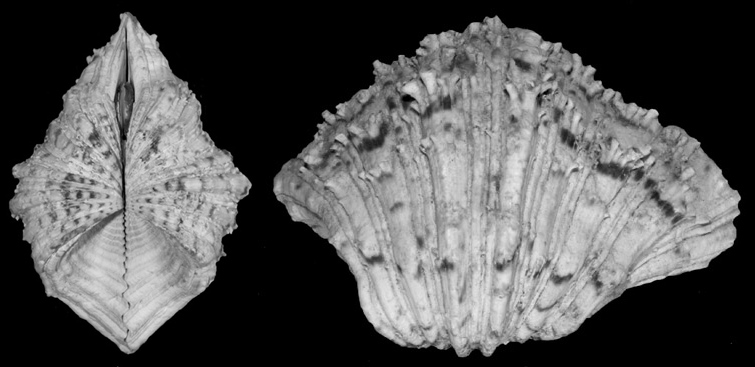
The shells of H. hippopus also bear red markings, which are especially prominent on smaller specimens.
The fleshy upper mantle tissue comes in a variety of looks. It’s often rather dull gray to brownish-gray without colorful or fancy markings, but some are quite attractive, as you can see below. There are three things that are particularly unusual about its mantle, though. It always has a rugose texture, being very knobby/lumpy looking, and it extends very little past the edge of the shell, or not all. Instead of extending it further, the shell gapes open widely and thus exposes a relatively large amount of the mantle anyway.
Two other giant clams, H. hippopus and H. porcellanus, don’t extend their mantle past the edge of the shell either, but the rest of the giant clams can and typically do. The mantle also lacks eyes, like H. hippopus and H. porcellanus, while all the other species have them. Interesting, indeed. Lastly, its inhalent siphon, which is the large opening in the mantle, is always ringed by prominent tentacles, which are usually white.3
When it comes to this species and the reef aquarium hobby, as I said above, there has been at least one specimen imported into the US . In February of 2015, Ecological Reef Farms Tonga collected the specimen on the above right and shipped it to a dealer here. Apparently it has an expected retail price tag of $2,000. 8 That’s a lot of money for a clam, of course, but I’ve seen a large blue T. squamosa sell for more than twice that.
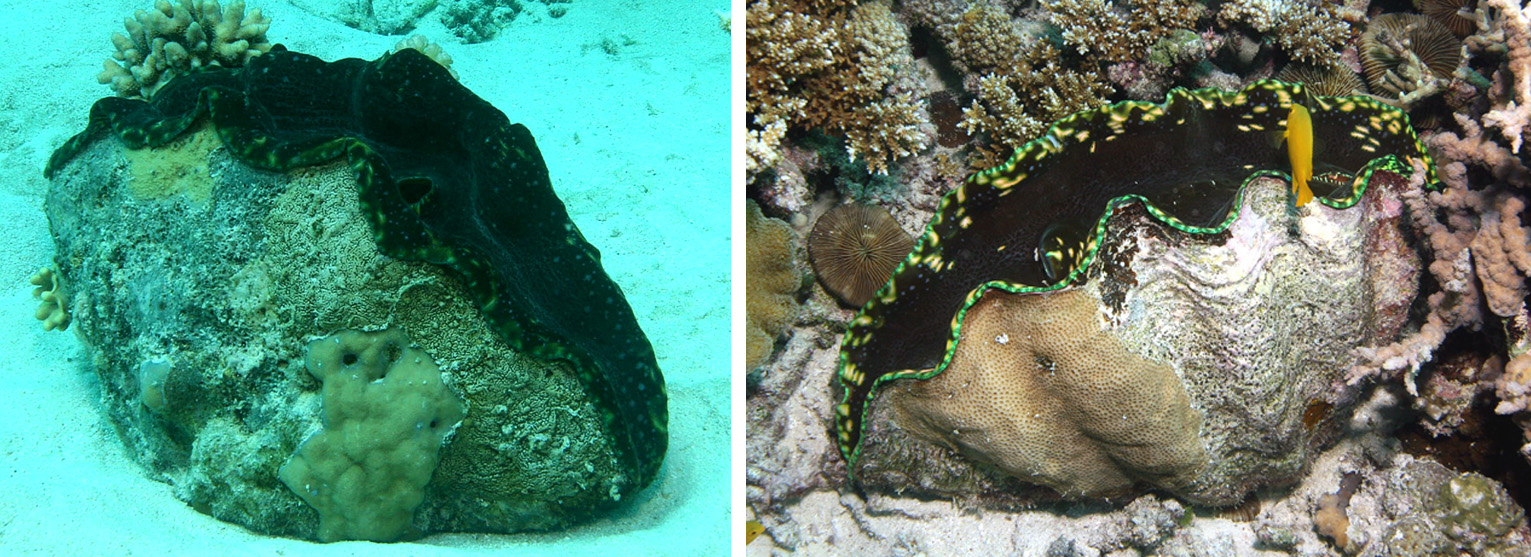
Note that the shell of T. mbalavuana can look very similar to those of some T. derasa. Two such T. derasa pictured here, from the Great Barrier Reef.
This species was also successfully aquacultured at the Tonga Fisheries hatchery in the early 1990’s, although it was problematic and not many clams were produced.9 Still, with a price (and profit) like that, and a proven ability to farm them, regardless of problems, I think there’s a good chance that more will become available in the future. Considering their paucity on the reefs, and relatively small geographic range, I certainly do not think any significant quantities of them will be collected from the wild, though.
In the event that more are imported, I’ll offer some care advice. Considering that this species is typically found in relatively deep water, it is important to give any specimen time to acclimate to intense reef aquarium lighting.
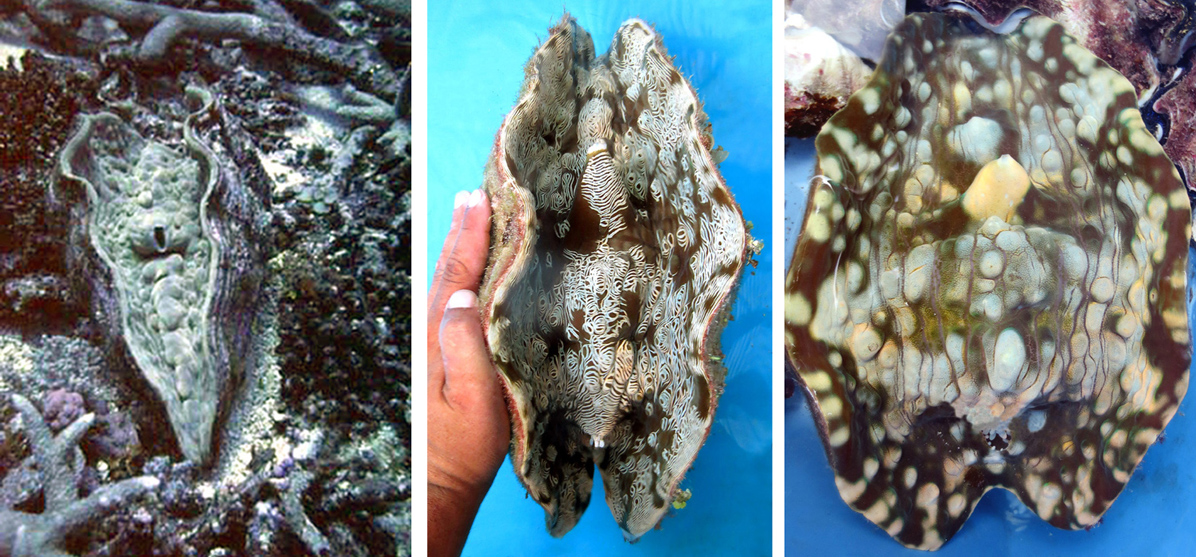
Three specimens of T. mbalavuana. Used with permission, courtesy Dr. Richard Braley (aquasearch.net.au) (L), and Ecological Reef Farms Tonga (M & R).
The mantles of giant clams contain structures called iridophores that are made of small groups of cells called iridocytes, which contain stacks of tiny reflective platelets. These can serve multiple functions, but one of them is to help block damaging ultraviolet light. Mycosporine-like amino acids ( MAAs) are also found in the mantle and serve the same purpose, along with some non-photosynthetic pigments.
There is little need to produce these when living at depth, and it has been found that T. mbalavuana has few such iridocytes.3 Thus, it can be rather intolerant of strong illumination. In fact, several specimens died when collected and moved into much shallower waters during initial collections, and was reported to have shown “great sensitivity to sunlight” when moved to the surface.1 Fortunately, more specimens were collected and kept in protective cages at a greater depth of approximately 14m for study and breeding activities.3
Still, in the case with other giant clams, specimens from dimmer waters can typically be slowly acclimated to brighter light over a period of a few weeks, giving them time to produce various materials for dealing with the increase in illumination/UV. Of course, it remains to be seen if this can be accomplished with this species, though. I hope whoever buys/bought the one from Tonga reads this, or has already done their homework!
Tridacna squamosina:
In 2005, a doctoral student described a unique giant clam found only in the Gulf of Aqaba, which is one of the little fingers at the northern end of the Red Sea. It’s appearance was similar to T. maxima and T. squamosa, which are also found in the Gulf of Aqaba and Red Sea proper, but not the same as either. Genetic testing and its reproductive timing, which is not the same as the others, verified that it was different, too.10 It was subsequently named Tridacna costata, and further searching eventually led to the discovery of this clam in other parts of the Gulf of Aqaba, and off the Egyptian coast in the northern part of the Red Sea proper.11
However, as was the case above, it turns out that this species had already been discovered and named many years earlier. During an exploratory expedition in late 1800’s, several specimens of the same clam had been collected in the Gulf of Aqaba and one from the Southern Red Sea off Yemen . These were named Tridacna elongata var. squamosina.12
The specimens had been in the collections of the Natural History Museum in Vienna, Austria , and were re-evaluated just a few years ago. This analysis indicated that the specimens were indeed the same clam as the ones that had been named T. costata. So, after some taxonomic re-working, T. costata became a junior synonym of T. squamosina.13
The geographic range of the species (at least in the recent past) was then known to cover the Gulf of Aqaba and much of the Red Sea proper at that point, as one specimen had been collected much further south, off Yemen. However, it is now known that its range extends well down the west coast of Africa in the Indian Ocean, and is abundant around the Bazaruto Archipelago off the coast of Mozambique.14 This is almost as far south as the southern end of Madagascar. Whether its range extends even further south, and how far it extends to the east, is unknown at this time, though.
While it’s now known to be abundant in some areas in the Indian Ocean, it is indeed a rarity in the Red Sea. Surveys indicated that it made up less than 1% of current giant clams stocks there, being found at a ratio of approximately one T. squamosina to every 167 T. maxima and T. squamosa.11 Thus, it was initially suggested that it should be considered “critically endangered” by the International Union for Conservation of Nature. It’s interesting to note that, to the contrary, over 80% of fossil tridacnid shells found in the same region are T. squamosina, leading to the idea that this species has been heavily overfished going back as far as the early human occupation of the area roughly 100,000 years ago.11
With the history covered, let’s get to appearances. The shell is white, is elongated, and has 5 to 7 deep folds in it, with relatively large, rather pointed tooth-like projections emerging from the upper part of each half. The two halves do not close tightly when pulled together, and there are significant gaps between the tooth-like projections when it is closed as much as it can be. The shell also bears numerous shelf-like scutes, which tend to be well-spaced closer to the bottom of the shell and relatively crowded on the upper part. There’s a moderately-sized byssal opening in the bottom of the shell, as well. Thus, it does look similar to, but obviously not identical to, typical shells of T. maxima. Lastly, it also has the same maximum length as T. maxima, at 40cm (almost 16 inches).15,16

Three specimens of T. squamosina. Used with permission, courtesy of Mrutzek Meeresaquaristik (L & M), and Nicole Helgason (R).
As is common for giant clams, the mantle tissue is quite variable in appearance, and bears a wide range of colors and patterns. It’s also papillose, meaning it’s covered with little knob-like protrusions. These structures, which are properly called papillae, cover the mantle and are more pronounced and numerous on larger specimens, while the mantles of T. maxima and T. squamosa tend to be relatively smooth. However, some T. maxima and T. squamosa, do bear papillae, although they are fewer in number. The inhalent siphon is ringed with tentacles, like T. maxima and T. squamosa, as well.

Note that some T. maxima shells (L & M) look similar to those of T. squamosina, bearing relatively large “teeth” at the top of the shell. Some T. maxima also bear papillae on their mantle, seen as the small bumps on it (R).
Another thing of note is that it’s typically attached to the substrate, and is found only in relatively shallow water.10 Those found off the coast of Mozambique were in approximately 2 to 9m of water.14 However, all specimens found in the Gulf of Aqaba and northern Red Sea were living at depths less than 2m.11 If this species does not live any deeper than 9m, then it has the smallest vertical distribution of all clams in the genus Tridacna, with the exception of T. crocea, which typically lives within 6m of the surface.

While T. squamosina (L) looks similar to many T. maxima, and is genetically closest to T. maxima, some do look much like some T. squamosa (R). T. squamosina photograph used with permission, courtesy of Julian Sprung.
To finish up on this species, I’ll again point out that, to the best of my knowledge, it has not been imported into the US . After communicating with several people in the trade, it apparently has not been aquacultured, either. Thus, it is highly unlikely that any will become available in the near future. However, while searching the internet, I did find a photograph at reeflex.net (http://dk.reeflex.net/tiere/2628_Tridacna_squamosina.htm) of a juvenile in an aquarium with T. squamosa. So, somebody, somewhere has had one in a reef aquarium. This site has several photographs of this species if you want to see more.
More to Come?
While reading up on these two species, I found that researchers had done genetic testing on numerous clams in the Red Sea and in 2006 proposed that there were actually two new species related to T. maxima there, as well as one new species related to T. squamosa.17 So, we may find out that there are others there, too. Likewise, as mentioned above, there are two other new species of giant clam found in the Indian and Pacific Oceans, and have already been offered in the hobby. Again, those will be the subject of another article, though.
References:
- Lewis, A.D. and E. Ledua. 1988. A possible new species of Tridacna (Tridacnidae: Mollusca) from Fiji . In: Copeland, J.W. and J.S. Lucas (eds.) Giant Clams in Asia and the Pacific. ACIAR Monograph Number 9, Canberra. 274pp
- Lucas, J.S., E. Ledua, and R.D. Braley. 1990. A new species of giant clam (Tridacnidae) from Fiji and Tonga . ACIAR Working Paper Number 33, Canberra. 8pp.
- Lucas, J.S., E. Ledua, and R.D. Braley. 1991. Tridacna tevoroa Lucas, Ledua, and Braley: a recently-described species of giant clam (Bivalvia: Tridacnidae) from Fiji and Tonga . Nautilus 105:92-103.
- Ladd, H.S. 1934. Geology of Viti Levu, Fiji . Bernice B. Bishop Museum Bulletin 119:1-263.
- Braley, R. undated. Giant Clam Species. Aquasearch, URL: http://www.aquasearch.net.au/aqua/clamculture.htm
- Ledua, E., N. Manu and R. Braley, 1993. Distribution, habitat and culture of the recently described giant clam Tridacna tevoroa in Fiji and Tonga . In: Fitt, W.K. (ed.) Biology and Mariculture of Giant Clams. ACIAR Proceedings No. 47. 154pp
- Lewis, A.D., T.J.H. Adams, and E. Ledua. 1988. Fiji ‘s giant clam stocks – A review of their distribution, abundance, exploitation and management. In: Copeland, J.W. and J.S. Lucas (eds.) Giant Clams in Asia and the Pacific. ACIAR Monograph Number 9, Canberra. 274pp.
- Adams, J. 2015. personal communication.
- Ledua, E., N. Manu and R. Braley, 1993. Distribution, habitat and culture of the recently described giant clam Tridacna tevoroa in Fiji and Tonga . In: Fitt, W.K. (ed.) Biology and Mariculture of Giant Clams. ACIAR Proceedings No. 47. 154pp.
- Roa-Quiaoit, H. 2005. Ecology and culture of giant clams (Tridacnidae) in the Jordanian sector of the Gulf of Aqaba, Red Sea. Doctoral dissertation, University of Bremen. URL: http://elib.suub.uni-bremen.de/publications/dissertations/E-Diss1340_PHDROAQ.pdf
- Richter, C., Roa-Quiaoit, H., Jantzen, C., Al-Zibdah, M., and Kochzius, M. 2008. Collapse of a new living species of giant clam in the Red Sea. Current Biology 18:1-6.
- Sturany, R. 1899. Expedition S.M. Schiff “Pola” in das Rothe Meer. Nördliche und südliche Hälfte. 1895/96 und 1897/98. Zoologische Ergebnisse XIV Lamellibranchiaten des ROthen Meeres. Berichte der Commision für oceanographische Forschungen. Sonderdruck aus: Denkschriften der mathematisch-naturwissenschaftlichen Classe der Kaiserlichen Akademie der Wissenschaften, Wien, 69:225-295.
- Huber M. and Eschner A. 2011. Tridacna (Chametrachea) costata Roa-Quiaoit, Kochzius, Jantzen, Al-Zibdah & Richter from the Red Sea, a junior synonym of Tridacna squamosina Sturany, 1899 (Bivalvia, Tridacnidae). Annalen des Naturhistorisches Museum Wien, ser. B, 112:153-162.
- Helgason N., SCUBA instructor, Mozambique . 2015. personal communication.
- Kinch, J. 2002. Giant clams: their status and trade in Milne Bay Province, Papau New Guinea .TRAFFIC Bulletin 19(2):1-9.
- Richter, C. in Mitchell, E. 2008. New giant clam species discovered. BBC News. URL: http://news.bbc.co.uk/2/hi/science/nature/7588857.stm
- Mohamed, N.M., Hill, R.T., Kilada, R.W., Khalifa, S.I., and Abou-El-Ela, S.H. 2006. Molecular genetic analysis of giant clam (Tridacna sp.) populations in the northern Red Sea. Asian Journal of Biochemistry 1(4):338-342.



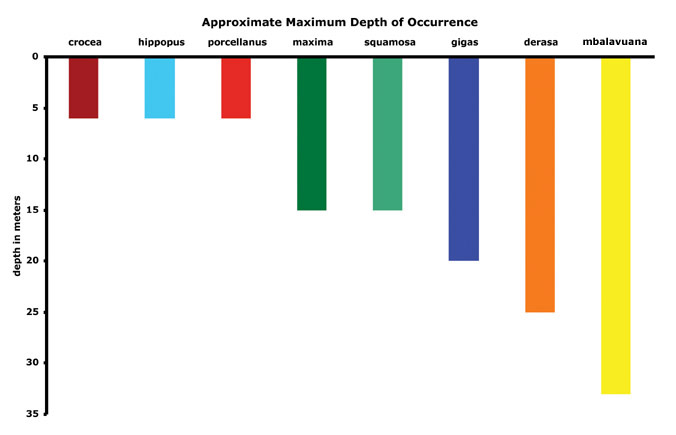
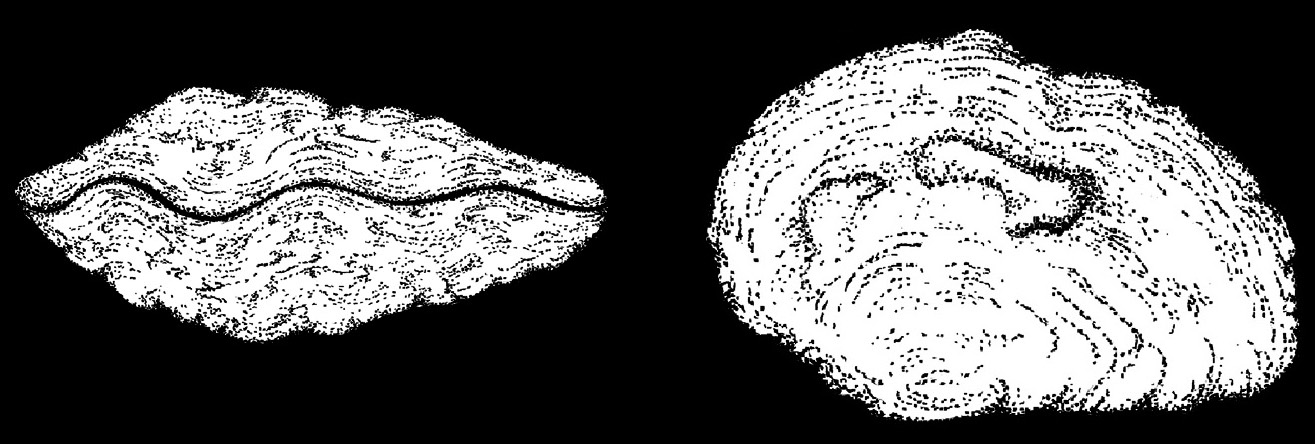
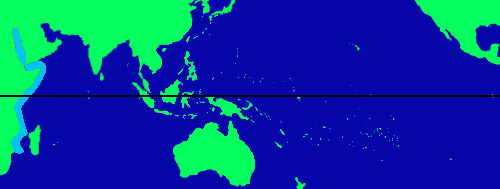
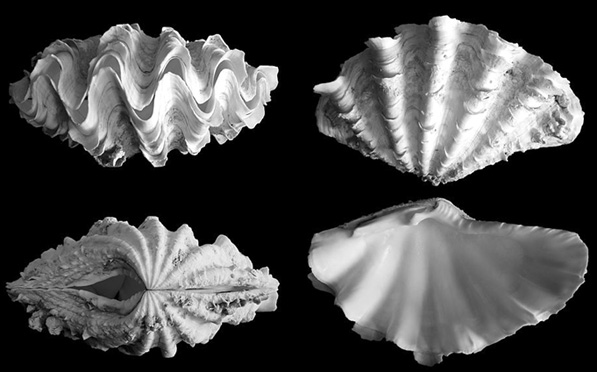

0 Comments